Attached files
| file | filename |
|---|---|
| EX-99.1 - EXHIBIT 99.1 - CALIX, INC | ex991pressrelease20q1.htm |
| 8-K - 8-K - CALIX, INC | form8-kearningsrelease20q1.htm |
Exhibit 99.2

April 28, 2020
Fellow Calix stockholders:
Since our founding in 1999, we have never seen a future more uncertain. As the coronavirus has spread around the world and, in the absence of widespread testing, treatment or vaccine, no one knows how or when this terrible crisis will end. What is clear is the escalating human cost and the massive change in society this will bring.
Our mission is to connect everyone and everything, and with the world challenged by a pandemic, this is more important than ever. There are two secular disruptions moving like a wave through the communications industry, and as we shared with you at our Investor Day on March 4th, we are perfectly positioned to ride both. It is clear this pandemic will only accelerate these disruptions. It has changed our daily lives in almost every way from what they were just a few months ago. The way we live, work and play has changed dramatically.
As a company, we are focused first and foremost on the health and welfare of our employees and their families. We have been building a virtual culture for years. In early March, we accelerated this shift by moving to an all-virtual mode. We are proud to say that the team has executed seamlessly throughout this shift. Being healthy and strong, we can continue to serve the needs of our customers.
In turn, our customers across the globe continue to work tirelessly in order to meet the increased needs of their subscribers. For many of us this may prove to be a new normal in terms of how we work, how our children are educated, how entertainment is accessed and how we interact with friends, family and colleagues for the foreseeable future. Given more activity taking place at home on digital and social platforms, we have already seen, and are likely to continue to see, greater strain on service provider broadband networks across the globe. This in turn requires service providers to respond. Many are increasing capacity on their networks in order to handle the higher data traffic. In addition, for many innovative service providers, this presents an opportunity to seek better tools in order to do this most expeditiously and cost effectively. Insights and analytics available in Calix Cloud and tools inside EXOS and AXOS fit perfectly within this new normal as they enable service providers to reduce network complexity, decrease subscriber churn due to service outages and dramatically shrink network issue resolution time. All with the clear focus on providing the best possible subscriber experience. We are increasingly seeing service providers of all types adapt to this new normal and turn to Calix to support them.
With service providers of all types responding to the increased demand for their services, the value of our all platform offerings continues to resonate, and demand for our platforms continues to grow. Our expanding addressable market was demonstrated yet again this quarter as we added 18 new customers. As has been the trend over the past quarters, most of these new customers came from emerging customer verticals. This continued expansion of our customer base is fundamental to our transformation and will create a foundation for predictable, profitable growth for years to come.
1
Riding the Wave of Disruption
Our vision is focused on providing the platforms and services that enable innovative service providers to create services at a DevOps pace and provide their subscribers with an exceptional experience.
Service providers achieve this objective by building their infrastructure and service offerings on platforms. The ongoing wave of disruption sweeping across the communications space remains unprecedented in our experience. We continue to see traditional business models being disrupted as service providers of all types learn to adapt to the demands of the device-enabled subscriber. As the market continues to disrupt, the gap between subscriber needs and service provider supply continues to grow. New service providers are being created to address this unmet need, and capital is being formed to support them. We see this investment accelerating in the market, and it is well aligned with our mission; and we see the pace of existing service providers transforming to address this need hastening as well. As these service providers realign their investments, we are finding areas where our platforms can help them grow. In short, when a service provider of any type chooses to own the subscriber experience, we are well positioned to help them succeed.
Continued Transformation to an All Platform Company
Our relentless focus on the transformation of Calix into a communications cloud and software platform business yielded further progress in the first quarter. As we stated in our prior letters to stockholders, we continue to believe this transformation will manifest in improved financial performance across four measurable metrics over the long term:
• | Gross margin expansion |
• | Disciplined operating expense investment |
• | Deliberate revenue growth |
• | Increased predictability |
In the first quarter of 2020, we made further progress on these metrics, and we expect these metrics will continue to improve as our platforms increase as a percentage of our total business. Examples of our progress made in the quarter were:
• | Added 18 new customers in the quarter from all segments of the market. |
• | Continued rapid growth with Calix Cloud as revenue more than doubled compared to the year ago quarter. |
• | Expanded the EXOS platform to more than 300 customers. |
• | Experienced another strong quarter with AXOS platform shipments increasing by 50% compared to the year ago quarter. |
• | Launched a series of new enhanced services such as Network Capacity Assessment Service as well as added functionality to Managed Services that enable our customers to quickly respond to the substantial increases in network traffic they are experiencing in the near-term. |
Our near-term focus is on serving the needs of our service provider customers, while our long-term focus remains on finding like-minded customers regardless of their type, size or location. Furthermore, we remain committed to aligning our investments to our strategy and maintaining strong discipline over our operating expenses. Over the long term, we believe this focus will drive continuous improvement in our financial performance.
2
First Quarter 2020 Financial Results
Actual GAAP | Actual Non-GAAP | Guidance Non-GAAP | |
Revenue | $101.7M | $101.7M | $99M - $103M |
Gross margin | 44.9% | 46.7% (1) | 45.0% - 47.0% (1) |
Operating expenses | $52.0M | $49.2M (1) | $48.5M - $50.5M (1) |
Net loss per diluted common share | ($0.12) | ($0.04) (1) | ($0.08) - ($0.04) (1) |
Operating cash flow | $1.2M | $1.2M | Negative |
(1) Non-GAAP excludes items such as stock-based compensation, U.S. tariff and tariff-related costs and intangible asset amortization. See GAAP to non-GAAP reconciliations beginning on page 14.
Overall results for the first quarter of 2020 were solidly within our financial guidance for the quarter. Total revenue was above the mid-point of our guidance range and grew year-over-year for the second consecutive quarter, increasing 14% compared to the year-ago quarter, as we saw another strong quarter of demand for our platforms and the continued ramp of new offerings with the large majority of growth coming from our small customer base. Non-GAAP gross margin was near the high-end of our guidance owing to improvement in our services gross margin. Meanwhile, our non-GAAP operating expenses were below the mid-point of our guidance range due to our continued focus on maintaining financial discipline. In addition, we generated positive operating cash flow due to a decline in inventory owing to supply disruptions related to the coronavirus outbreak in China as well as maintaining disciplined operating expense investments. This marks the first time we have generated positive operating cash flow in the first fiscal quarter in four years and marks our third consecutive quarter of positive operating cash flow generation.
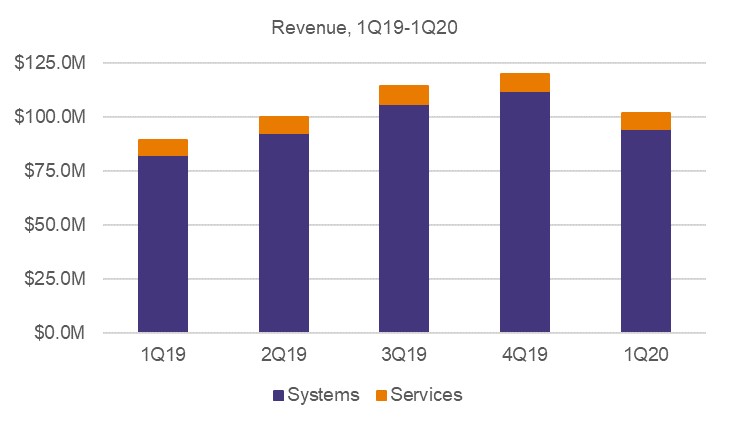
Systems revenue for the first quarter of 2020 increased 15% compared to the year ago quarter due to demand for our Calix Cloud, EXOS and AXOS platforms as well as improved supply relative to the year ago supply constrained quarter partially offset by continued pressure on our legacy systems revenue. Compared to the prior quarter, systems revenue decreased by 16%, in line with normal seasonality. Services revenue increased 3% compared to the year ago quarter as the continued ramp in our next generation service offerings was only partially offset by lower professional services related to CAF deployments. Compared to the prior quarter, services declined by 13% due to lower professional services as 2019 projects were closed out last quarter. We continue to align our services business with our all-platform model through the creation of higher differentiated-value services.
3
Domestic revenue was 87% of total revenue in the first quarter and increased 16% compared to the year ago quarter as stronger demand for our platforms as well as improved product supply relative to the year ago quarter, which was negatively impacted by production challenges and delays associated with our global supply chain realignment. International revenue was 13% of total revenue in the first quarter and was flat compared to the year ago quarter.
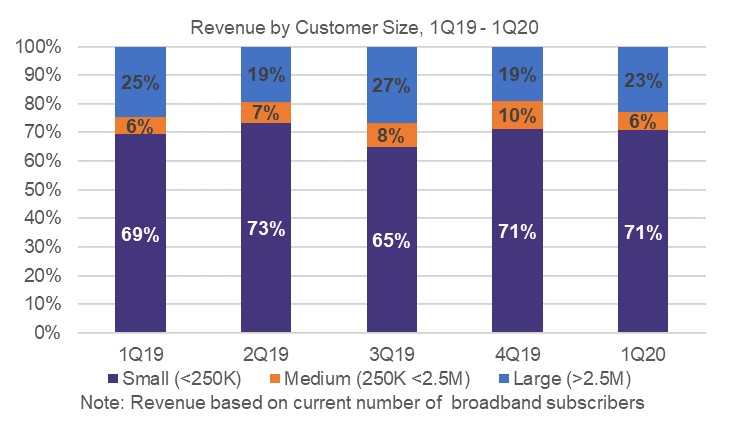
Revenue from large customers was 23% of total revenue in the first quarter of 2020 and increased by 7% compared to the year ago quarter primarily due to greater shipments to CenturyLink, which represented 15% of revenue. Revenue from medium-sized customers was 6% of total revenue in the first quarter of 2020 and increased 6% compared to the year ago quarter reflecting increased demand among a small subset of these customers. Revenue from small customers was 71% of total revenue in the first quarter of 2020 and increased 17% as compared to the year ago quarter due to continued strength in demand for Calix Cloud and AXOS platforms. We will continue to focus on finding strategically aligned customers for our all-platform business.
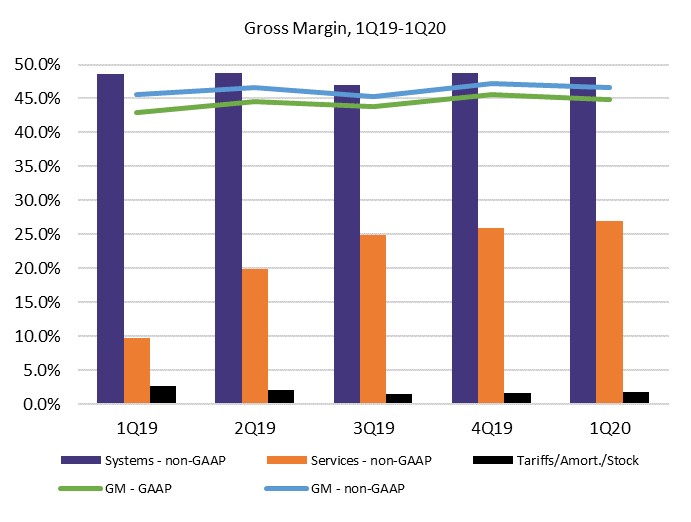
Driven by improved gross margin in our services business, both GAAP and non-GAAP gross margin, increased in the first quarter of 2020 relative to the year-ago quarter. Specifically, non-GAAP gross margin increased 110 basis points year over year. On a GAAP basis, systems gross margin increased 50 basis points compared to the year ago quarter due to lower U.S. tariff and tariff-related costs partially offset by customer and product mix. U.S. tariff and tariff-related costs and intangible asset amortization costs were 170 basis points of systems gross margin compared to 260 basis points in the year ago quarter. On a non-GAAP basis, systems gross margin decreased approximately 40 basis points year-over-year. The principal drivers of the year-over-year decrease in systems gross margin were customer and product mix partially offset by continued growth in our all-platform offerings. Sequentially, on a non-GAAP basis, systems gross margin decreased by 50 basis points mainly due to overhead absorption on the lower sequential revenue. On a GAAP basis, services gross margin increased by 17 percentage points compared to the year ago quarter primarily due to improved mix towards our higher gross margin support services versus lower gross margin deployment services. Sequentially, on a GAAP basis, services gross margin increased by 80 basis points again due to a higher mix of support services as compared to deployment services.
4
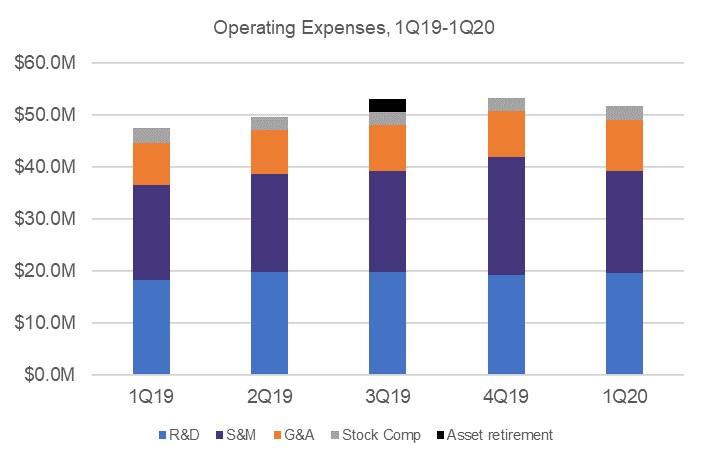
Operating expenses on both a GAAP and non-GAAP basis increased compared to the year ago quarter. The increase was predominately attributable to the inclusion of a full quarter of incentive compensation expense. A year ago, no bonuses were earned as we missed our quarterly financial targets. Sequentially, on a GAAP and non-GAAP basis, operating expenses in the first quarter decreased by 2% and 3%, respectively. The sequential decrease was primarily due to our ConneXions user group conference that occurs in the fourth quarter and lower sales commissions due to lower revenue partially offset by the resumption of expensing personnel expenses related to our cloud-based ERP implementation that were previously capitalized as well as an increase in amortization from our new ERP system as it went live at the beginning of 2020. As demonstrated this quarter, we expect to maintain our operating expense leverage, while maintaining our pace of innovation.
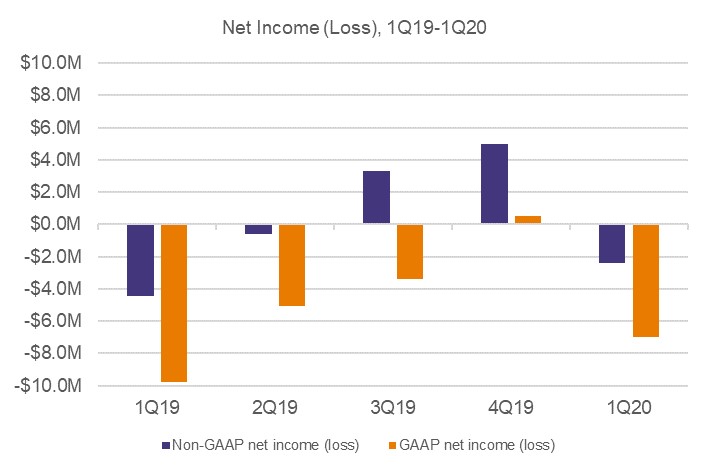
We reported a net loss on both a GAAP and non-GAAP basis in the first quarter of 2020. However, our net loss on both a GAAP and non-GAAP basis improved compared to the net loss reported in the year ago quarter. Our GAAP net loss decreased by $2.9 million year-over-year from $9.8 million to $6.9 million. Our GAAP net loss for the first quarter of 2020 included stock-based compensation of $3.0 million, U.S. tariff and tariff-related costs of $1.0 million and intangible asset amortization of $0.6 million. With the increased revenue and higher gross margin compared with the year ago quarter, our non-GAAP net loss for the first quarter of 2020 improved by $2.2 million from $4.5 million to $2.3 million.
5
Balance Sheet and Cash Flow
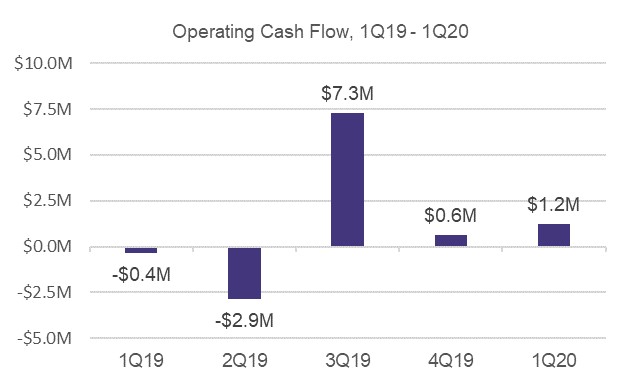
We ended the first quarter of 2020 with cash of $46.2 million, a sequential decrease of $0.6 million. The sequential decrease in our cash was primarily the result of positive operating cash flow of $1.2 million offset by capital expenditures of $1.7 million. Compared to the year ago quarter, our cash increased by $2.1 million primarily due to positive operating cash flow of $6.3 million and proceeds from equity-based employee benefit plans of $9.7 million partially offset by capital investments of $10.0 million and payments under financing arrangements of $2.9 million. Operating cash flow doubled sequentially as the lower net income was offset by improvements in working capital. We believe our existing cash, operating cash flow and line of credit will provide us sufficient liquidity for our business operations while navigating the uncertainty created by the coronavirus pandemic.
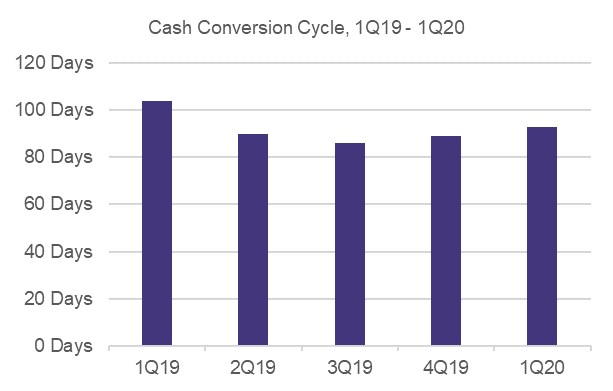
Our team remains focused on operational excellence and customer satisfaction. During the first quarter of 2020, our supply chain was disrupted by the coronavirus outbreak in China. Consequently, our days sales outstanding at quarter end was 58 days, up 22 days from the prior quarter and up 3 days from the prior year as shipments during the quarter were more backend loaded due to supply constraints and delays with invoicing related to our ERP migration. Inventory turns were 5.2 at quarter end, compared to 4.7 turns in the prior quarter and 3.4 turns in the year ago quarter. The higher inventory turns in the quarter were directly related to the supply disruption. We ended with lower inventory than expected. Days payable outstanding at quarter end was 35 days up 10 days from the prior quarter and down 23 days from the year ago quarter. Our cash conversion cycle increased slightly to 93 days compared to 89 days in the prior quarter owing to the just mentioned supply constraint-driven backend loaded nature of the quarter and invoicing delays. Compared to the year ago quarter, our cash conversion cycle decreased by 11 days from 104 days owing to improved inventory velocity.
6
Second Quarter 2020 Guidance
Guidance Non-GAAP | Guidance Reconciled to GAAP | |
Revenue | $110M - $114M | $110M - $114M |
Gross margin | 46.0% - 48.0% (1) | 44.6% - 46.6% |
Operating expenses | $48.0M - $50.0M (1) | $50.7M - $52.7M |
Net income (loss) per diluted common share(2) | $0.03 - $0.07 (1) | ($0.04) - $0.00 |
Operating cash flow | Positive | Positive |
(1) | Non-GAAP excludes items such as stock-based compensation, U.S. tariff and tariff-related costs and intangible asset amortization. See GAAP to non-GAAP reconciliation on page 14. |
(2) | Based on 57.7 million weighted-average diluted common shares outstanding. |
Our guidance for the second quarter of 2020 reflects our expectations as of the date of this letter. These expectations reflect the normal seasonality in our business as well as our current estimate of the global impacts from the coronavirus pandemic on our business in the second quarter of 2020.
Our non-GAAP gross margin guidance for the second quarter of 2020 reflects continued growth of our platform offerings as well as favorable customer, product and regional mix, partially offset by a sequential increase in expediting costs as we continue to face the challenge of supply limitations.
Our non-GAAP operating expense guidance for the second quarter of 2020 reflects similar levels of headcount along with decreases in travel and entertainment expenses. Consistent with past quarters, we remain focused on operating expense investment discipline.
Finally, we expect positive operating cash flow next quarter reflecting non-GAAP profitability and continued focus on working capital velocity.
Importantly, we remain committed to improved financial performance over the long term as demonstrated by the Target Financial Model provided at our 2020 investor day on March 4, 2020, which remains unchanged.
Summary
Given the coronavirus challenges impacting everyday life across the globe, we are proud of our team as they focused on executing on behalf of our customers. Strong demand for our platforms along with the rapid expansion of our customer base continues to demonstrate the progress we made towards our mission in the first quarter. As we remain focused on executing on our market opportunity and supporting our customers, we expect to see our financial performance over the long term continue to improve.
In the first quarter of 2020, we demonstrated solid revenue growth and positive operating cash flow. Based on a strong backlog exiting the quarter and a strong pipeline of platform opportunities, we are excited to project another quarter of double-digit year-over-year revenue growth, improved profitability and our fourth consecutive quarter of positive operating cash flow.
7
We see many innovative service providers looking to Calix to provide the solutions and services to enable them to improve their subscribers’ experience, thereby driving their revenue higher, lowering their churn and increasing their return on investment. With an expanding pipeline of opportunities spanning service providers of every type, we believe we are well placed to continue building Calix … an all platform company … that is positioned in front of the largest wave of disruption our industry has experienced. We remain committed to our vision, and we sincerely thank our employees, customers and stockholders for their continued support as we capitalize on this opportunity.
Sincerely,
 Carl Russo President & CEO |  Cory Sindelar CFO |
8
Conference Call
In conjunction with this announcement, Calix will host a conference call tomorrow, April 29, 2020, at 5:30 a.m. Pacific Time (8:30 a.m. Eastern Time) to answer questions regarding our first quarter 2020 financial results. A live audio webcast and replay of the call will be available in the Investor Relations section of the Calix website at http://investor-relations.calix.com.
Live call access information: Dial-in number: (877) 407-4019 (U.S.) or (201) 689-8337 (outside the U.S.)
The conference call and webcast will include forward-looking information.
Investor Inquiries
Thomas J. Dinges, CFA
Director of Investor Relations
408-474-0080
Tom.Dinges@calix.com
About Calix
Calix, Inc. (NYSE: CALX) - Innovative communications service providers rely on Calix platforms to help them master and monetize the complex infrastructure between their subscribers and the cloud. Calix is the leading global provider of the cloud and software platforms, systems and services required to deliver the unified access network and smart premises of tomorrow. Our platforms and services help our customers build next generation networks by embracing a DevOps operating model, optimize the subscriber experience by leveraging big data analytics and turn the complexity of the smart, connected home and business into new revenue streams.
Forward-Looking Statements
Statements made in this stockholder letter and the earnings call referencing the stockholder letter that are not statements of historical fact are forward-looking statements. Forward-looking statements are subject to the “safe harbor” provisions of the Private Securities Litigation Reform Act of 1995. Forward-looking statements relate to, but are not limited to, statements about the impact of the coronavirus pandemic, potential customer or market opportunities, growth and pipeline opportunities, statements about customer anticipated purchase trends, expected customer and product mix or anticipated adoption of our platforms, systems or services offerings, industry, market and customer trends, opportunities with existing and prospective customers, the ongoing management of our global supply-chain, the performance of our recently implemented ERP system, the future impact, financial or otherwise, of the U.S. tariffs or any other tariffs or trade regulations that may be imposed whether by the United States or other countries, as well as our ability to effectively mitigate such impacts, and future financial performance (including the outlook for the second quarter of 2020). Forward-looking statements are subject to risks and uncertainties that could cause actual results to differ materially from expectations, including but not limited to fluctuations in our financial and operating results, the capital spending decisions of our customers, changes and disruptions in the market and industry, availability of capital in the market, changes in regulations and/or government sponsored programs, competition, our ability to achieve market acceptance of new systems and solutions, our ability to grow our customer base, fluctuations in costs associated with our systems and services including higher costs due to project delays and changes, third-party dependencies for production and resource management associated with our global supply-chain that may cause delays in production and unavailability of systems to meet customer orders, which may be substantial, cost overruns and other unanticipated factors, as well as the risks and uncertainties described in our annual reports on Form 10-K and our quarterly reports on Form 10-Q, each as filed with the SEC and available at www.sec.gov, particularly in the sections titled “Risk Factors.” Forward-looking statements speak only as of the date the statements are made and are based on information available to us at the time those statements are made and/or management’s good faith belief as of that time with respect to future events. Calix assumes no obligation to update forward-looking statements to reflect actual performance or results, changes in assumptions or changes in other factors affecting forward-looking information, except to the extent required by applicable securities laws. Accordingly, investors should not place undue reliance on any forward-looking statements.
Use of Non-GAAP Financial Information
The Company uses certain non-GAAP financial measures in this stockholder letter to supplement its consolidated financial statements, which are presented in accordance with GAAP. These non-GAAP measures include non-GAAP gross margin, non-GAAP operating expenses, non-GAAP net income (loss) and non-GAAP net income (loss) per diluted common share. These non-GAAP measures are provided to enhance the reader’s understanding of the Company’s operating performance as they primarily exclude certain non-cash charges for stock-based compensation, intangible asset amortization, restructuring benefit,
9
U.S. tariff and tariff-related costs and loss on asset retirement, which the Company believes are not indicative of its core operating results. Management believes that the non-GAAP measures used in this stockholder letter provide investors with important perspectives into the Company’s ongoing business performance and management uses these non-GAAP measures to evaluate financial results and to establish operational goals. The presentation of these non-GAAP measures is not meant to be a substitute for results presented in accordance with GAAP, but rather should be evaluated in conjunction with those GAAP results. A reconciliation of the non-GAAP results to the most directly comparable GAAP results is provided in this stockholder letter. The non-GAAP financial measures used by the Company may be calculated differently from, and therefore may not be comparable to, similarly titled measures used by other companies.
10
Calix, Inc. | |||||||||||
Condensed Consolidated Statements of Operations | |||||||||||
(Unaudited, in thousands, except per share data) | |||||||||||
Three Months Ended | |||||||||||
March 28, | March 30, | ||||||||||
2020 | 2019 | ||||||||||
Revenue: | |||||||||||
Systems | $ | 94,509 | $ | 82,360 | |||||||
Services | 7,173 | 6,990 | |||||||||
Total revenue | 101,682 | 89,350 | |||||||||
Cost of revenue: | |||||||||||
Systems (1) | 50,708 | 44,601 | |||||||||
Services (1) | 5,350 | 6,406 | |||||||||
Total cost of revenue | 56,058 | 51,007 | |||||||||
Gross profit | 45,624 | 38,343 | |||||||||
Operating expenses: | |||||||||||
Research and development (1) | 20,671 | 19,330 | |||||||||
Sales and marketing (1) | 20,624 | 19,339 | |||||||||
General and administrative (1) | 10,669 | 8,787 | |||||||||
Total operating expenses | 51,964 | 47,456 | |||||||||
Loss from operations | (6,340 | ) | (9,113 | ) | |||||||
Interest and other expense, net: | |||||||||||
Interest expense, net | (290 | ) | (108 | ) | |||||||
Other income (expense), net | 15 | (391 | ) | ||||||||
Total interest and other expense, net | (275 | ) | (499 | ) | |||||||
Loss before provision for income taxes | (6,615 | ) | (9,612 | ) | |||||||
Provision for income taxes | 329 | 155 | |||||||||
Net loss | $ | (6,944 | ) | $ | (9,767 | ) | |||||
Net loss per common share: | |||||||||||
Basic and diluted | $ | (0.12 | ) | $ | (0.18 | ) | |||||
Weighted average number of shares used to compute net loss per common share: | |||||||||||
Basic and diluted | 56,540 | 54,048 | |||||||||
(1) | Includes stock-based compensation as follows: | ||||||||||
Cost of revenue: | |||||||||||
Systems | $ | 107 | $ | 155 | |||||||
Services | 115 | 99 | |||||||||
Research and development | 1,010 | 1,016 | |||||||||
Sales and marketing | 956 | 1,074 | |||||||||
General and administrative | 796 | 801 | |||||||||
11
Calix, Inc. | ||||||||
Condensed Consolidated Balance Sheets | ||||||||
(Unaudited, in thousands) | ||||||||
March 28, | December 31, | |||||||
2020 | 2019 | |||||||
ASSETS | ||||||||
Current assets: | ||||||||
Cash and cash equivalents | $ | 46,189 | $ | 46,829 | ||||
Restricted cash | 628 | 628 | ||||||
Accounts receivable, net | 67,136 | 46,509 | ||||||
Inventory | 30,539 | 40,153 | ||||||
Prepaid expenses and other current assets | 11,223 | 9,698 | ||||||
Total current assets | 155,715 | 143,817 | ||||||
Property and equipment, net | 20,402 | 21,527 | ||||||
Right-of-use operating leases | 15,212 | 15,864 | ||||||
Goodwill | 116,175 | 116,175 | ||||||
Other assets | 16,550 | 19,440 | ||||||
$ | 324,054 | $ | 316,823 | |||||
LIABILITIES AND STOCKHOLDERS’ EQUITY | ||||||||
Current liabilities: | ||||||||
Accounts payable | $ | 20,464 | $ | 10,789 | ||||
Accrued liabilities | 57,975 | 57,546 | ||||||
Deferred revenue | 19,912 | 17,158 | ||||||
Line of credit | 30,000 | 30,000 | ||||||
Total current liabilities | 128,351 | 115,493 | ||||||
Long-term portion of deferred revenue | 17,656 | 18,340 | ||||||
Operating leases | 13,642 | 14,337 | ||||||
Other long-term liabilities | 13,490 | 14,625 | ||||||
Total liabilities | 173,139 | 162,795 | ||||||
Stockholders’ equity: | ||||||||
Common stock | 1,549 | 1,545 | ||||||
Additional paid-in capital | 899,978 | 895,899 | ||||||
Accumulated other comprehensive loss | (1,106 | ) | (854 | ) | ||||
Accumulated deficit | (709,520 | ) | (702,576 | ) | ||||
Treasury stock | (39,986 | ) | (39,986 | ) | ||||
Total stockholders’ equity | 150,915 | 154,028 | ||||||
$ | 324,054 | $ | 316,823 | |||||
12
Calix, Inc. | ||||||||
Condensed Consolidated Statements of Cash Flows | ||||||||
(Unaudited, in thousands) | ||||||||
Three Months Ended | ||||||||
March 28, | March 30, | |||||||
2020 | 2019 | |||||||
Operating activities: | ||||||||
Net loss | $ | (6,944 | ) | $ | (9,767 | ) | ||
Adjustments to reconcile net loss to net cash provided by (used in) operating activities: | ||||||||
Stock-based compensation | 2,984 | 3,145 | ||||||
Depreciation and amortization | 3,544 | 2,281 | ||||||
Loss on asset retirements | — | 95 | ||||||
Changes in operating assets and liabilities: | ||||||||
Accounts receivable, net | (20,627 | ) | 11,823 | |||||
Inventory | 9,614 | 2,925 | ||||||
Prepaid expenses and other assets | 758 | (1,935 | ) | |||||
Accounts payable | 9,472 | (6,349 | ) | |||||
Accrued liabilities | 1,367 | (1,614 | ) | |||||
Deferred revenue | 2,071 | 719 | ||||||
Other long-term liabilities | (990 | ) | (1,696 | ) | ||||
Net cash provided by (used in) operating activities | 1,249 | (373 | ) | |||||
Investing activities: | ||||||||
Purchases of property and equipment | (1,729 | ) | (5,039 | ) | ||||
Net cash used in investing activities | (1,729 | ) | (5,039 | ) | ||||
Financing activities: | ||||||||
Proceeds from exercise of stock options | 1,099 | 290 | ||||||
Taxes paid for awards vested under equity incentive plan | — | (27 | ) | |||||
Payments related to financing arrangements | (842 | ) | (653 | ) | ||||
Proceeds from line of credit | 30,000 | 30,000 | ||||||
Repayment of line of credit | (30,000 | ) | (30,000 | ) | ||||
Payments to originate the line of credit | (177 | ) | — | |||||
Net cash provided by (used in) financing activities | 80 | (390 | ) | |||||
Effect of exchange rate changes on cash, cash equivalents and restricted cash | (240 | ) | 223 | |||||
Net decrease in cash, cash equivalents and restricted cash | (640 | ) | (5,579 | ) | ||||
Cash, cash equivalents and restricted cash at beginning of period | 47,457 | 50,274 | ||||||
Cash, cash equivalents and restricted cash at end of period | $ | 46,817 | $ | 44,695 | ||||
13
Calix, Inc. | ||||||||||||||||||||||||||||||
Reconciliation of GAAP to Non-GAAP Systems Gross Margin and Gross Margin | ||||||||||||||||||||||||||||||
(Unaudited) | ||||||||||||||||||||||||||||||
Three Months Ended | ||||||||||||||||||||||||||||||
March 28, 2020 | December 31, 2019 | September 28, 2019 | June 29, 2019 | March 30, 2019 | ||||||||||||||||||||||||||
Systems Gross Margin | Gross Margin | Systems Gross Margin | Gross Margin | Systems Gross Margin | Gross Margin | Systems Gross Margin | Gross Margin | Systems Gross Margin | Gross Margin | |||||||||||||||||||||
GAAP amount | 46.3 | % | 44.9 | % | 47.1 | % | 45.5 | % | 45.4 | % | 43.9 | % | 46.6 | % | 44.5 | % | 45.8 | % | 42.9 | % | ||||||||||
Adjustments to GAAP amount: | ||||||||||||||||||||||||||||||
Stock-based compensation | 0.2 | 0.2 | 0.1 | 0.2 | 0.1 | 0.2 | 0.1 | 0.2 | 0.2 | 0.3 | ||||||||||||||||||||
Intangible asset amortization | 0.7 | 0.6 | 0.5 | 0.5 | 0.3 | 0.2 | — | — | — | — | ||||||||||||||||||||
U.S. tariff and tariff-related costs | 1.0 | 1.0 | 1.0 | 1.0 | 1.1 | 1.0 | 2.0 | 1.9 | 2.6 | 2.4 | ||||||||||||||||||||
Non-GAAP amount | 48.2 | % | 46.7 | % | 48.7 | % | 47.2 | % | 46.9 | % | 45.3 | % | 48.7 | % | 46.6 | % | 48.6 | % | 45.6 | % | ||||||||||
Calix, Inc. | ||||||||||||
Reconciliation of GAAP to Non-GAAP Operating Expenses | ||||||||||||
(Unaudited, in thousands) | ||||||||||||
Three Months Ended | ||||||||||||
March 28, 2020 | December 31, 2019 | March 30, 2019 | ||||||||||
GAAP operating expenses | $ | 51,964 | $ | 53,218 | $ | 47,456 | ||||||
Adjustment to GAAP amount - stock-based compensation | (2,762 | ) | (2,502 | ) | (2,891 | ) | ||||||
Non-GAAP operating expenses | $ | 49,202 | $ | 50,716 | $ | 44,565 | ||||||
Calix, Inc. | |||||||||||||||||||||
Reconciliation of GAAP to Non-GAAP Net Income (Loss) | |||||||||||||||||||||
(Unaudited, in thousands) | |||||||||||||||||||||
Three Months Ended | |||||||||||||||||||||
March 28, | December 31, | September 28, | June 29, | March 30, | |||||||||||||||||
2020 | 2019 | 2019 | 2019 | 2019 | |||||||||||||||||
GAAP net income (loss) | $ | (6,944 | ) | $ | 497 | $ | (3,379 | ) | $ | (5,045 | ) | $ | (9,767 | ) | |||||||
Adjustments to GAAP amount: | |||||||||||||||||||||
Stock-based compensation | 2,984 | 2,705 | 2,762 | 2,569 | 3,145 | ||||||||||||||||
Intangible asset amortization | 658 | 658 | 352 | — | — | ||||||||||||||||
U.S. tariff and tariff-related costs | 959 | 1,138 | 1,097 | 1,855 | 2,151 | ||||||||||||||||
Loss on asset retirement | — | — | 2,474 | — | — | ||||||||||||||||
Non-GAAP net income (loss) | $ | (2,343 | ) | $ | 4,998 | $ | 3,306 | $ | (621 | ) | $ | (4,471 | ) | ||||||||
14
Calix, Inc. | ||||
Reconciliation of GAAP to Non-GAAP Net Loss Per Diluted Common Share | ||||
(Unaudited) | ||||
Three Months Ended March 28, 2020 | ||||
GAAP net loss per diluted common share | $ | (0.12 | ) | |
Adjustments to GAAP amount: | ||||
Stock-based compensation | 0.05 | |||
Intangible asset amortization | 0.01 | |||
U.S. tariff and tariff-related costs | 0.02 | |||
Non-GAAP net loss per diluted common share (1) | $ | (0.04 | ) | |
(1) Based on 56.5 million weighted-average diluted common shares outstanding.
Calix, Inc. | ||||||||||
Reconciliation of GAAP to Non-GAAP Guidance | ||||||||||
(Unaudited, dollars in thousands, except per share data) | ||||||||||
Three Months Ending June 27, 2020 | ||||||||||
GAAP | Stock-Based Compensation | U.S. Tariff and Tariff-related Costs | Intangible Asset Amortization | Non-GAAP | ||||||
Gross margin | 44.6% - 46.6% | 0.2% | 0.6% | 0.6% | 46.0% - 48.0% | |||||
Operating expenses | $ 50,700 - $ 52,700 | $ (2,700) | $ - | $ - | $ 48,000 - $ 50,000 | |||||
Net income (loss) per diluted common share(1) | $ (0.04) - $ 0.00 | $ 0.05 | $ 0.01 | $ 0.01 | $ 0.03 - $ 0.07 | |||||
(1) Based on 57.7 million weighted-average diluted common shares outstanding.
15
